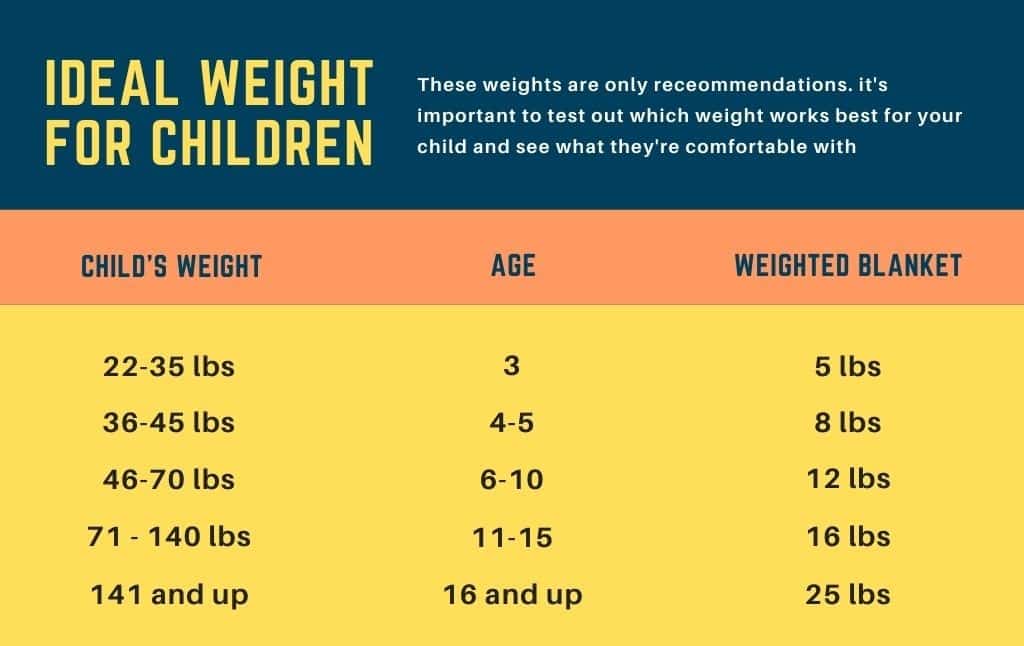How heavy should a weighted blanket be for a child?
This post may contain affiliate links. Read the full disclosure here
A weighted blanket is used to help people who have anxiety, autism, ADHD, and other disorders by providing deep touch pressure. The pressure is meant to stimulate the nervous system and release calming hormones.
As you’ve likely learned, the benefits of weighted blankets can be huge for adults. But what about kids? There are plenty of benefits to using a weighted blanket for children too, including:
- Better sleep quality and reduced bedtime struggles.
- Reduced anxiety and improved mood.
- Improved focus and attention during the day.
But how heavy should a weighted blanket be for a child? And how do you make sure the blanket is well-made? These are important questions to ask when looking at options for your child. The answers can save you money and frustration in the long run.
How heavy should a weighted blanket be for a child?
Well, the first thing you’ll want to consider is your child’s age and body weight. Weighted blankets are recommended for children over the age of 5. To determine the ideal blanket weight for your child, here’s a chart to help you figure out the right weight:

Other considerations for buying a weighted blanket for your child
1. Fabric
Fabric is a big factor! Some fabrics can be quite itchy and irritating to sensitive skin. Others can be too heavy or hot. And some can’t hold up against regular use. Here are some tips for picking the right fabric for you: Cotton is soft and breathable but may not be strong enough to hold up against regular use and washing. Some cotton weighted blankets have been known to tear after repeated use.
Soft minky fabrics are warm and cozy, but they may not be strong or durable enough to hold up against regular use.
Cotton-polyester blends are breathable, durable, and inexpensive but may not feel as soft or cozy as pure cotton or minky fabrics. A blend of 50% cotton and 50% polyester is typical.
Wool blends are also breathable but may not be warm enough for some people in cold climates.
Polyester can feel soft and cozy but isn’t as breathable as other fabrics; it may also feel hotter than other fabrics in warmer climates or during exercise.
Acrylic is another popular material that feels soft and cozy but isn’t as breathable as other materials; it also feels hot in warmer climates or during exercise.
2. Fillers
The fillers in weighted blankets are usually a mix of poly pellets, glass beads, rice hulls, and flaxseed. Poly pellets are the most common filler for weighted blankets sold on Amazon, but they’re also one of the priciest options.
Rice hulls are made from rice husks and are usually found in higher quality blankets. They’re more expensive than plastic pellets but are also more durable.
Flaxseed is another high-quality filler that has some health benefits as well. The seeds have a nice texture and can add some pleasant smell to your blanket. However, they’re more expensive than glass beads or rice hulls — especially if you get organic flax seeds — so keep this in mind while shopping.
3. Distribution of weight
If you’re looking for a weighted blanket for your child, it’s important to find one that not only provides the right amount of weight but also distributes the weight evenly.
The most common distribution of weight is evenly distributed across the blanket. This means that all parts of the blanket have the same amount of weight, so there are no “hot spots” or areas where you feel more or less pressure than others.
If you’re looking for more customized options, you might want to consider a customizable weighted blanket. These blankets are usually made from cotton, which allows you to place weights wherever you want on the blanket. This can help ensure that your child is comfortable with the blanket weight. An adjustable weighted blanket also means that it can grow with your child.
4. Machine-washable
If you’re looking for a weighted blanket, you may have noticed that there are many options online. Some are made of cotton and others are made of polyester. Some come with removable covers, while others do not. Some are machine washable, while others are dry clean only.
From personal experience trying to wash a weighted blanket, most machines aren’t made to handle the weight.
5. Adjustability
Adjustability is key: The first thing you need to look for when buying a weighted blanket for a child is adjustability. Some children need more weight than others, but you’ll want to make sure that the blanket can be adjusted accordingly so that it’s safe and effective. You don’t want your child growing out of his or her blanket too quickly!
6. Sizing
The size of the weighted blanket you purchase should match the size of your child’s bed. For example, if you buy a 10 lb weighted blanket for a twin-size bed, it should be about 5 feet wide by 7 feet long. This will allow your child to comfortably fit under the blanket with a little extra room on top.
Another option is a weighted vest for children which can be used even when your child is being active rather than laying down.

